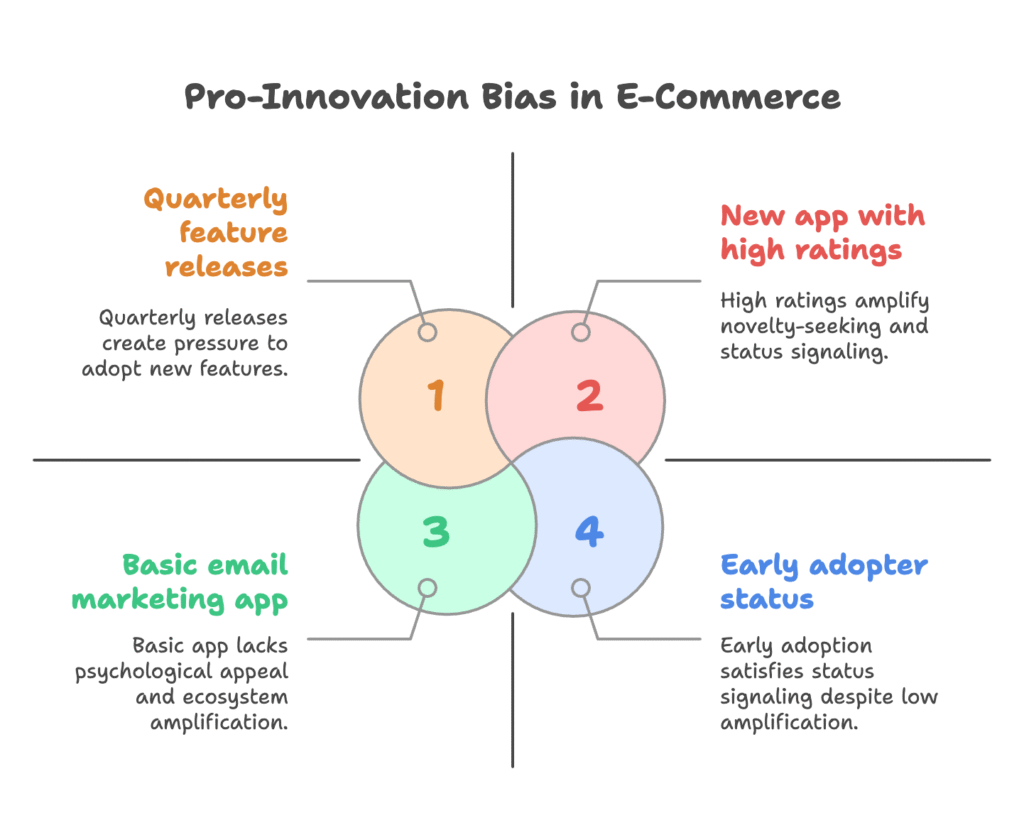Ever find yourself installing a new Shopify app every few weeks, convinced it’s the missing piece to your conversion puzzle? Or maybe you’ve spent hours comparing features of similar apps, only to end up with a slower site and confused customers?
You’re not alone. Welcome to the world of pro-innovation bias – our brain’s sneaky tendency to assume new equals better, often leading us down expensive rabbit holes.
Here’s the thing: while innovation drives progress, blindly chasing every shiny new feature can actually hurt your business. But what if you could harness the power of new tools while avoiding the common traps that catch most merchants?
In this article, you’ll discover why your brain tricks you into overvaluing new solutions, learn the hidden costs of feature addiction, and master a framework for evaluating Shopify apps and features objectively. By the end, you’ll have the tools to make smarter decisions that actually move your business forward.
Ready to break free from the innovation trap? Let’s dive in.
Understanding Pro-Innovation Bias in E-Commerce
In this section, we’ll unpack what pro-innovation bias really means and why it hits Shopify merchants particularly hard. You’ll understand the psychological forces at play and recognize how the Shopify ecosystem amplifies these tendencies.

What Is Pro-Innovation Bias?
Pro-innovation bias is your brain’s built-in assumption that newer solutions are automatically better than existing ones. It’s the voice in your head saying, “This new app will finally solve everything!” while conveniently forgetting about the three similar apps you already tried.
This bias isn’t new. In the 1950s, nuclear energy was going to solve all our problems. The 1980s promised us paperless offices. Each generation gets caught up in the promise of revolutionary technology, often overlooking practical limitations.
But why do we fall for this repeatedly? Three psychological drivers keep us hooked:
- Novelty-seeking brain chemistry: Our brains release dopamine when we encounter something new, making innovation feel literally rewarding
- Status signaling through early adoption: Being first to try new tools makes us feel innovative and forward-thinking
- Fear of missing competitive advantages: Nobody wants to be left behind while competitors gain an edge
How the Shopify Ecosystem Amplifies This Bias
The Shopify App Store is like a candy shop for innovation addicts. With over 100 apps in single categories and constant “trending” and “just launched” sections, it’s designed to trigger your novelty-seeking instincts.
Consider this: You’re browsing email marketing apps and see one with 4.9 stars and another with 4.7 stars. Your brain immediately gravitates toward the higher-rated option, but what if that 0.2-star difference represents just five more positive reviews? Meanwhile, you’re ignoring crucial factors like integration complexity or long-term costs.
The platform’s quarterly feature releases create another pressure point. Each update brings new capabilities, making you feel like you need to implement them immediately or risk falling behind. This creates what experts call “shiny object syndrome” – constantly jumping to the next new thing without fully utilizing what you already have.
Now that you understand how your brain gets hijacked by innovation appeals, let’s explore the real damage this bias can inflict on your business. Spoiler alert: it’s probably costing you more than you think.
The Cost of Unchecked Pro-Innovation Bias
Here’s where we get into the nitty-gritty of what innovation obsession actually costs your business. From financial drain to customer confusion, the hidden expenses might surprise you.

The Financial Drain
Let’s talk numbers. The average Shopify merchant spends over $1,500 per year on apps. But that’s just the subscription costs. Factor in implementation time (your hours aren’t free), developer fees for custom integration, staff training, and documentation updates, and you’re looking at a much bigger investment.
Here’s a real example: Sarah runs a jewelry store and decided to upgrade her abandoned cart recovery system. The new app cost $49/month instead of her current $29/month solution. Seems reasonable, right? But she also paid $500 for setup, spent 15 hours learning the new system, and had to retrain her assistant. Her total cost for the “upgrade”? Nearly $2,000 in the first year alone.
The worst part? Her recovery rates improved by only 2%.
Then there’s the opportunity cost – all those hours spent implementing and learning new tools could have been invested in content creation, customer outreach, or product development.
Operational Chaos
App stacking creates its own problems. Each new app adds another layer of complexity to your store’s architecture. Apps can conflict with each other, causing mysterious bugs that are nightmare to debug. Your site speed suffers as each app loads its own scripts and styles.
Staff productivity takes a hit too. Every new tool means new workflows, new dashboards to check, and new systems to maintain. Context-switching between different platforms wastes mental energy and increases the chance of errors.
Customer Experience Nightmares
While you’re busy optimizing behind the scenes, your customers are dealing with the fallout. Inconsistent user interfaces across integrated apps create a disjointed shopping experience. Too many features overwhelm visitors – think popup overlays stacked on live chat widgets competing with discount countdown timers.
Broken integrations are even worse. Imagine a customer adding items to their cart through your recommendation engine, only to find those items missing when they reach checkout because two apps didn’t communicate properly.
But here’s what’s really fascinating: the biases driving these poor decisions go much deeper than simple tool selection. Let’s explore the psychological traps that make smart merchants make questionable choices.
Cognitive Biases Amplifying Innovation Fixation
In this section, we’ll dive into the specific mental shortcuts that lead even experienced merchants astray. Understanding these biases is your first step toward making more rational decisions.
The Big Three Psychological Mechanisms
Technological Solutionism is the belief that every business problem requires a technological solution. Low conversion rates? There’s an app for that. Poor customer retention? Another app will fix it. This thinking ignores simpler solutions like improving product descriptions or streamlining your checkout process.
Anchoring Effect happens when developers showcase impressive benefits upfront while burying integration costs in fine print. You anchor on “increase conversions by 25%” and discount the weeks of setup time and potential conflicts with existing tools.
Social Proof Cascade occurs when you follow competitor choices without understanding their specific context. Just because another store in your niche uses a particular app doesn’t mean it’s right for your business model, customer base, or technical setup.
Merchant-Specific Decision Traps
The Feature Checklist Fallacy is particularly dangerous. You compare apps based on feature counts rather than usability. An app with 50 features sounds better than one with 10, but those extra 40 features might be things you’ll never use while making the core functions harder to access.
Premature Optimization strikes when you implement advanced solutions before mastering the basics. Installing a sophisticated AI recommendation engine when your product photos are low-quality and descriptions are sparse is like putting racing stripes on a car with a broken engine.
Sunk Cost Rationalization keeps you stuck with problematic apps because you’ve already invested time and money. “We’ve spent three weeks setting this up; we can’t switch now” becomes a self-imposed prison sentence.
Recognizing these biases is crucial, but knowledge alone isn’t enough. You need a systematic approach to cut through the mental noise and evaluate tools objectively. Let’s build that framework together.
The Balanced Evaluation Framework for Shopify Technologies
Here’s where we get practical. This section will give you a step-by-step framework for evaluating any new Shopify technology objectively. Think of it as your BS detector for app marketing claims.
Strategic Alignment Assessment
Before you even look at apps, start with problem validation. Write down the specific issue you’re trying to solve. “Increase sales” is too vague. “Reduce cart abandonment for mobile users during checkout” is specific and measurable.
Ask yourself: Have you actually confirmed this is a real problem? Look at your analytics. If only 2% of your visitors are abandoning carts, maybe focusing on traffic quality would yield better results than optimizing cart recovery.
Next, assess competitive advantage potential. Will this solve a problem that gives you an edge, or are you just keeping up with table stakes? A unique product recommendation algorithm might differentiate you, while basic email marketing automation is expected by customers.
Objective Technical Evaluation
Now for the technical nitty-gritty. Test every app’s impact on page load speed. Anything adding more than 0.5 seconds should raise red flags. Use tools like Google PageSpeed Insights before and after installation.
Mobile responsiveness isn’t optional anymore. Test the app across different devices and browsers. If it breaks your mobile experience, it’s not worth considering – especially since mobile traffic often represents 60%+ of e-commerce visits.
Evaluate integration complexity honestly. Does the app require custom code modifications? Will it conflict with your existing theme or other apps? Can your team handle the maintenance, or will you need ongoing developer support?
Total Cost of Ownership Calculation
Look beyond monthly subscription fees. Project costs over three years, including:
- Setup and implementation: Developer time, your time, any required customizations
- Training and adoption: Staff learning curve, productivity dips during transition
- Maintenance: Updates, troubleshooting, compatibility issues
- Exit costs: Data export fees, migration time if you need to switch
A $19/month app might actually cost $2,000+ per year when you factor in everything.
Having a framework is great, but implementation is where the magic happens. Let’s explore how to build evaluation rituals that become second nature in your business.
Practical Implementation: Creating Innovation Evaluation Rituals
This section transforms theory into practice. You’ll learn how to create systematic processes that prevent impulsive app installations and ensure thoughtful technology adoption.
Stage-Gate Process for App Adoption
Create a formal process that every new app must pass through. Start with a Discovery Protocol:
- Document the specific problem before researching solutions
- Interview 3-5 customers about the issue (you might discover it’s not as big a problem as you thought)
- Explore non-app solutions first: Could better staff training, improved processes, or content changes solve this?
For the Evaluation Methodology, create a standardized scorecard rating apps on functionality, ease of use, integration complexity, support quality, and total cost. Involve multiple team members in the review process – different perspectives catch different issues.
Always pilot test before full implementation. Start with a limited product set or customer segment. Set specific success criteria upfront: “If cart abandonment doesn’t decrease by at least 5% within 30 days, we’ll reconsider.”
Plan your rollback strategy before you start. Know how to remove the app cleanly if things don’t work out, including any data export requirements.
Master the Art of Negative Review Analysis
Here’s a counterintuitive tip: Spend more time reading negative reviews than positive ones. Positive reviews often reflect initial excitement, while negative reviews reveal long-term issues and support quality.
Look for patterns in 1-3 star reviews. If multiple merchants mention “works great at first but breaks after updates” or “support takes days to respond,” take note. Check how developers respond to negative feedback – defensive responses or no responses are red flags.
Test support responsiveness yourself. Submit a pre-sales question and time their response. If they’re slow before you’re a customer, expect worse service after.
These systematic approaches work, but sometimes learning from others’ mistakes is more powerful than theory. Let’s look at some real-world cases where pro-innovation bias led merchants astray.
Case Studies: Pro-Innovation Bias in Action
Nothing beats real-world examples to illustrate how innovation bias plays out. These cases will help you recognize similar situations in your own decision-making.
Case Study: The Checkout Optimization Disaster
Meet Tom, who runs a home decor store with solid revenue but wanted to boost conversions. He discovered an app promising “revolutionary checkout optimization” with testimonials showing 30%+ conversion improvements.
Without testing, Tom replaced Shopify’s native checkout with this third-party solution. The interface looked sleeker and had more features like one-click upsells and social login options.
The result? Conversions dropped 17% within two weeks.
Why did this happen? Tom’s customers were familiar with standard checkout flows. The new interface, while feature-rich, was unfamiliar and slightly slower to load. The one-click upsells actually distracted from completing the primary purchase.
The lesson: Incremental A/B testing would have revealed these issues before full implementation. Sometimes “revolutionary” changes confuse customers who just want to buy your products quickly and easily.
Case Study: The Marketing Automation Overkill
Lisa owns a jewelry brand and was attracted to an all-in-one marketing app with email automation, SMS, social media scheduling, review management, and loyalty programs. The feature list was impressive, and the price seemed reasonable for everything included.
Six months later, Lisa realized she was using only 30% of the features but paying for the full package. Worse, the general-purpose tools weren’t as effective as specialized alternatives for the features she actually needed.
Her mistake was falling for the Feature Checklist Fallacy – assuming more features equal better value. In reality, focused tools that excel at specific functions often outperform jack-of-all-trades solutions.
The lesson: Match app capabilities to your actual workflow needs, not your wish list. Start with focused solutions and only consider comprehensive platforms when you’ve outgrown specialized tools.
These examples show how good intentions can lead to poor outcomes. But don’t worry – there’s a path forward that balances innovation with objectivity.
Balancing Innovation with Objectivity: Best Practices
In this final section, we’ll explore sustainable practices for staying innovative while avoiding the pitfalls of bias. These strategies will help you build a culture of thoughtful technology adoption.
Create a Culture of Thoughtful Adoption
Establish an Internal Innovation Review Board, even if it’s just you and one other person. Having multiple perspectives prevents individual biases from dominating decisions. Set approval thresholds: anything over $100/month or requiring significant time investment needs board approval.
Implement quarterly app audits. Review what you’re paying for, how much you’re actually using each app, and whether redundancies exist. Create a “one-in, one-out” policy – for every new app you add, consider removing an existing one.
Document your decisions. Keep notes on why you chose specific apps and what problems they were supposed to solve. This creates accountability and helps you learn from both successes and failures.
Data-Driven Decision Making
Establish clear success metrics before implementing any new technology. Don’t just track vanity metrics – focus on business outcomes. If you’re installing a review app, track actual sales impact, not just review collection rates.
Create before/after performance benchmarks. Take screenshots, export relevant data, and document current processes before making changes. This gives you concrete evidence of whether improvements actually occurred.
Schedule regular evaluation cycles: 30-day initial assessment, 60-day deeper analysis, and 90-day comprehensive review. Many apps show initial promise but reveal issues over time.
Use A/B testing whenever possible. Rather than changing everything at once, test new features with a subset of traffic or customers. This approach reduces risk and provides clearer data on effectiveness.
The Long Game
Remember, sustainable growth comes from optimizing what you have, not constantly adding new tools. Focus on mastering existing systems before adding complexity.
Build relationships with app developers who provide excellent support and regular updates. Long-term partnerships with reliable vendors are more valuable than chasing the latest trending apps.
Stay informed about industry trends, but resist the urge to implement everything immediately. Let others test new technologies first – being second or third to adopt often means avoiding early-stage bugs and integration issues.
Speaking of thoughtful innovation, if you’re looking to increase your store’s conversions without the complexity of multiple apps, Growth Suite offers intelligent, behavior-based discount targeting that respects your brand integrity. Learn how it can help your Shopify store at the Shopify App Store.
References
- Wikipedia Contributors. (n.d.). Pro-innovation bias. Wikipedia. https://en.wikipedia.org/wiki/Pro-innovation_bias
- Rockturn. (2024). Pro-Innovation Bias. Rockturn. https://www.rockturn.com/topic/pro-innovation-bias/
- Baumann, O., & Martignoni, D. (2011). The Contingent Value of a Pro-Innovation Bias. SBR, 63, 393-415. https://oliverbaumann.github.io/files/Baumann_Martignoni_2011_Pro-Innovation_Bias.pdf




